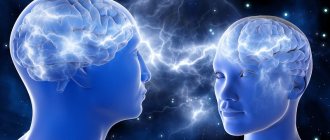Thinking is the main cognitive process that determines much in a person’s life. Associative thinking is a concept that reflects the use of associations: all connections between actions and ideas come from sensations and the traces they leave in the brain. Association is a connection between concepts and ideas that arises in the process of their awareness. One of the ideas evokes another in the mind - this is how associations are born.
Associative connections are not the same for different people, because they depend on personal experience. Thus, one person associates the word “autumn” with slush and bad weather, another – with bright yellow autumn flowers, a third – with a riot of colors in a deciduous forest, a fourth – with mushrooms and “quiet hunting”, a fifth – with loneliness , drizzling rain and a deserted alley stretching into the distance, strewn with withered leaves, and for the sixth - happy birthday, friends, gifts and fun.
The term “association” was introduced by the English philosopher and educator John Locke back in 1698, and has been widely used since then. Thanks to associative thinking, we get acquainted with new things, discover the world for ourselves, expand the boundaries of its knowledge, and learn to think outside the box.
Types of associations
There are different classifications of associations. For example, based on a number of characteristics, the following types can be distinguished:
- Cause - effect (rain - raincoat, lightning - thunder, snow - skis).
- Contiguity, proximity in time and space (sausage - refrigerator, computer - mouse).
- Similarity, similarity of concepts (cloud - feather bed, pear - light bulb).
- Contrast (white - black, fire - ice, cold - heat).
- Generalization (flower - bouquet, birch - tree).
- Submission (vegetable - tomato, bush - viburnum).
- Addition (borscht - sour cream, salad - mayonnaise).
- Whole and parts (body - hand, house - entrance).
- Subordination to one object (pincers - pliers, chair - bench, cup - glass).
There are also associations based on consonance (cat - midge, shadow - fence) and word-forming ones, built on words with the same root (sineva - blue, stove - baking).
In the process of building associations, different senses can be involved, so associations can be gustatory, visual, auditory, olfactory, etc.
Associative theory of thinking
The first ideas about the universal laws of human mental life were associated with the formation of associations . In the 17th century, the psychology of thinking had not yet been identified as a separate section, and thinking was not considered as a special form of human activity. The development of thinking was understood as a process of accumulation of associations.
The associative theory of thinking is one of the earliest. Its supporters believed that thinking is an innate ability and comes down to associations connecting traces of the past and impressions of present experience. Unfortunately, this theory could not explain the creative nature of the thinking process, the specificity of its content and the patterns of its occurrence.
However, based on the learning process, the associative theory of thinking highlighted several very significant points for the development of thinking:
- The importance of using visual material in the learning process;
- The realization that learning is possible only through sensory knowledge, i.e. through images and representations.
- Understanding that associations expand the boundaries of abilities, through them consciousness is stimulated, activating the processes of comparison, analysis, and generalization.
What are associations?
Association is a connection between individual facts, events, objects or phenomena reflected in a person’s mind and fixed in his memory. Associative perception and thinking of a person lead to the fact that the appearance of one element under certain conditions evokes the image of another associated with it.
The ability to make associations is the most important ability of our mind. There is even such a direction: associative psychology (or associationism), which tries to explain a person’s mental processes by studying his associations in connection with certain objects (stimulus - response); the process of memorizing information can also be considered from this point of view.
Development of associative thinking
Ideas suggested by associations have been successfully used by people for a long time. Observations of fish gave rise to the idea of creating a submarine, and the ascent and submersion systems were inspired by associations with the air bladder of a fish. The idea of echolocation was borrowed from dolphins. The burdock clinging to the dog's fur suggested to Georges de Menstral, an engineer from Switzerland, the principle of creating Velcro, which is now widely used in clothing and shoes. Many unrealized ideas suggested by associations were preserved in the notebooks of Leonardo Da Vinci. Thus, bird observations suggested to him the idea of an ornithopter, which would allow a person to soar above the ground. His sketches of a parachute are a reflection of the dream of a flying man, drifting in the heights, not afraid to fall from any height. And this is only a tiny part of the ideas inspired by associations, and the main thing is that this process cannot be stopped.
Developed associative thinking gives us a number of advantages:
- promotes the development of imagination;
- helps generate new, extraordinary ideas;
- facilitates perception and promotes the formation of new semantic connections;
- improves adaptation to new, non-standard situations and helps in finding solutions to unusual problems;
- stimulates brain function;
- improves memory capacity.
It is impossible not to mention that the basis of mnemonics, which allows you to memorize large volumes of words, are associations. You can learn more about associative memory in our article Associative Memory. Development of associative memory.
It is better to begin the development of associative thinking from early childhood, step by step. First, you just need to introduce the child to all the concepts encountered and the actions associated with them. The next stage is teaching the child to generalize. For example, cups, plates, saucers - dishes; chair, table, armchair - furniture; car, doll, cubes - toys. At the same time, the child learns to name and distinguish objects.
For older children, other, more complex exercises are needed: drawing up associative series, searching for a sequence in a word series, analyzing objects by attribute.
A child’s associative thinking can lead him to psychologically difficult situations. For a parent, in the case when a child reacts sharply negatively to an image or association (for example, vaccination - injection - doctor - white coat), it is important to understand that suppressed associations driven “into a dark corner” can cause the development of various kinds of complexes in the future. It is important to be patient, talk to your child about what scares him, explain, and be positive. You should listen to the child and his associations, try to understand his needs, images, aspirations in order to support the child, reassure him, and restore his sense of security.
18_Associative process disorder
tags:
Ataxia, Association, Thinking, Disorder, Associative, Healthy, Term, Somehow XVIII.
Essentially a disorder of the associative process. Manic incoherence or aprosexic ataxia. Asthenic or adynamic associative ataxia. Hallucinatory confusion. Hypotheses of Wernicke, Stransky and Bleuler. Atymic or schizophrenic associative ataxia. Perseveration or speech persistence. Habitual associations. Slips of the tongue. Associations by contrast. Quantitative relationship between associations in healthy and mentally ill individuals.
The third type of violation of associative activity, as already mentioned, is a disorder of the process of formation of associative reactions in essence, expressed in a violation of the very laws of the emergence and flow of associations, their regularity, correctness; in these cases, in contrast to cases of insufficiency of the associative process, despite the fact that the presence of the mental stock of ideas and ideas may turn out to be completely sufficient and even abundant, nevertheless, the correctness of thinking suffers.
The quality of thinking is judged by its external expression, that is, by actions, speech and writing; Not always, both among the mentally healthy and the mentally ill, thoughts are expressed in words; but when verbal images turn into speech that we perceive, then from the content and structure of this speech we conclude about the course and quality of associative processes in a given person.
The leaders of the orderly flow of associative reactions are target ideas, which, arising one after another, serve as milestones that direct thinking in a certain direction; if general, target ideas do not arise with sufficient clarity, or if they do not turn out to be sufficiently stable and appear changeable, then, of course, the smooth and coherent flow of thinking should be disrupted along with this; deprived of a common guiding and guiding principle, deprived of a unifying idea, the thought process loses its harmony and integrity; associations that float into consciousness do not obey the guiding principle, in connection with the nature of which, under normal conditions, the selection process occurs, and are to a certain extent random in nature. With the deviation of attention that characterizes manic states in manic-depressive psychosis, especially in connection with the acceleration and influx of ideas and ideas observed during this process, speech is obtained, the individual parts of which are not only not interconnected by a common idea, but often have a completely random motive for coherence, caused, for example, by consonance, simply by the fact that the given object came into the patient’s field of vision; the result is speech, the individual parts of which are so unrelated to each other that it is not possible to convey its general content; Having started to talk about something, the patient does not reach its logical conclusion in his speech.
9 pages, 4498 words
5. Formation of thinking and speech in the process of ontogenesis
...culture. Understanding speech Thinking and speech are not identical processes and do not merge with each other, although both of these processes are inseparable from each other. Speech understanding is ... the control of all cognitive processes and communication. Speech actively develops during training and education. Violation of thinking Violation of the operational side of thinking It is known that thinking is based on ...
Sometimes patients in this state pronounce only fragmentary words in consonance, often meaningless, sometimes separate, incoherent phrases; associations of an internal nature give way to external, familiar and sound combinations and rhymes. The patient jumps in his thoughts and in his speech from subject to subject, revealing a real leap of ideas (fuga idearum); thinking seems inconsistent in its parts, in its development; Such thinking is characterized by the term incohaerentia idearum - incoherence of ideas, disorder of coordination of ideas, and the correctness of their combinations.
Since the attention of patients in the described conditions can reach an extreme degree of instability, excluding the possibility of being aware of the environment, of their own thoughts and experiences, a more or less sharp decrease in the ability to navigate can develop, the conscious attitude towards the environment and one’s own personality is disrupted, and manic behavior develops. confusion.
Some analogy to what happens in a manic state is observed in dreams, when dream images, not connected by unifying ideas, quickly, kaleidoscopically change and follow one another and groups, often in completely unexpected and strange combinations; Another analogy can be found in a state of alcohol poisoning. To characterize manic disturbances in the correctness of associative processes, one can use the term manic ataxia or incoherence; Bearing in mind that manic incoherence stems primarily from a disorder of attention, it would be more accurate to designate it as aprosexic ataxia.
A sample of speech from a moderately excited patient who speaks a lot and quickly: the speech is fragmentary and is a reaction to one question from the doctor, posed in parentheses; a strong deviation of attention is visible: “I don’t sleep on climates...” (Doctor: what’s your last name) “This paper is soft1)... I wasn’t included in the census... when it came to verification, the enumerators also asked me for my last name... You wash your face and brush your teeth every day ... Signs of divisibility of numbers by 11... this has also been forgotten... the signs are very simple... Your pince-nez does not suit you... it’s better to look through binoculars... Have you ever dropped your binoculars in the theater, etc. Or: a doctor, holding out his hand: “Hello, D.” AND." “You know that I don’t shake hands, I wash myself with cologne at home. You can’t have enough eggs, and I don’t have slingshots... I want my salary to be delivered accurately on the 20th and to do my job productively. You cannot skin seven skins from one ox, and the empress cannot perform miracles and heal... and in every exemplary establishment they know how to shoe horses... Make sure that the taken things are returned to him (points to the patient)... after all, the nurse is an official of the imperial court, and she cannot the salary is enough, but he is a good fellow and without the selected gold things he cannot take the first prize. It can be cured if you don’t irritate it, but give it a bath of cologne, otherwise it will die.”
6 pages, 2909 words
Obsessive states, overvalued ideas, delusions, dementia, disorder...
... also the possibility of convincing the patient. The criterion of the lack of final conviction of patients in the reliability of their highly valuable ideas is sometimes overestimated. Of course, the lack of final conviction, the patient’s hesitation… its development. Both of these signs distinguish overvalued ideas from obsessions, since with obsessive states, patients realize the alienness of their painful experiences, without...
Another type of violation of the correct flow of associative reactions has a different origin; the disorder does not depend on the acceleration of the flow of ideas, it is not the result of a disorder of attention, although the latter can be deeply affected in these states and, even more so, contributes to the disruption of associative activity; it is caused by the primary defeat of the combinational process, which is reflected in the patient’s thinking, in his actions, and in his speeches. Thinking seems incoherent, first of all, because the individual parts of the associative process are not connected with each other, individual links drop out of the associative chain; incoherence can also intensify depending on the influence of elements from the content of the subconscious area that do not float into the field of clear consciousness and do not achieve the proper intensity and brightness; in such states, external impressions do not enter into a proper associative connection with previously formed ideas, the combination reactions necessary to identify new impressions with previous ones do not occur, as a result of which the patient does not recognize familiar faces, familiar surroundings, does not orient himself in the environment, in time, even in own personality; consciousness is darkened and confused.
Any complex logical operations in these states are unthinkable. According to a completely fair observation by Wernicke2), such patients can sometimes correctly fulfill a simple requirement, for example, give a hand, stick out their tongue, say their name, age; however, they are not able to do tasks that require more complex combinations, for example, they can indicate what number the hour and minute hand is on, but cannot tell the time, they can name the denomination and number of coins, but not their total value, and etc. The described condition can manifest itself with varying degrees of intensity; it can be expressed not only in a disorder of speech coherence, but also in disharmony and disorganization of gestures and actions, and can reach the degree of dyspraxia and apraxia.
Meynert 189) 299) described the lesion of associative activity in question in the form of mental disorder he identified and described, called amentia or acute insanity; Currently, this clinical concept has changed and narrowed; the described disorder of associations is characterized especially by sthenic psychoses, exhaustion psychoses, the so-called. asthenic confusion and infectious psychoses. The most appropriate term to denote this course of associations seems to be primary or asthenic, adynamic associative ataxia or incoherence, since the phenomenon is based on a primary disorder of the associative process in the form of its weakness and lethargy, caused by an asthenic state or intoxication of the nervous elements.
25 pages, 12056 words
107) Disorders of the sphere of sensations and psychosensory synthesis. Delineation...
... visual and auditory reflect, “confirm” any traumatic, extremely valuable experiences. 133) Formal thinking disorders, clinical variants, diagnostic significance. FRM - “how the patient thinks” is revealed... or manifestations of the law of physics, the illusion of inattention. Illusions in mental disorders: Affective illusions arise under the influence of a strong feeling - affect, strong...
To illustrate, I present a shorthand recording of a conversation between a doctor and a patient who exhibited the phenomena of asthenic associative ataxia.
Q. Tell me, what is your name? O. Son. Q. What is your name? O. Son Kolya. Q. How so? O. My name is M.V. No. Your name is E. A. O. Yes, yes, E. A. V. What day is it today? O. October 22. Q. Why do you say October 22 every day? O. Everything for Shurochka V., if it really is winter. Q. Who am I? A. You really don’t, then Shurochka V. or Kolya. Q. This is your son, but am I your son? A. Yes, I don’t know. Q. Where are you now? A. In a hospital in Tiflis, or maybe in a palace. Q. Why are you in the palace? A. Let Dr. P. answer, he is here. (Dr. P. has nothing to do with the clinic).
Q. Tell me something. O. Yes, Shurochka D., it’s me. Here is a lotus for the whole world, the world for a lotus. I-Yu. Q. Artist Y.? A. Artist... Q. Is your husband dead? A. For a long time. Q. How many years ago? (Silence for a long time).
A. All for glory. Q. Tell me, what am I showing you? A. A watch, a symbol of patience. Q. What time is it? A. On the contrary, I don’t know anything. I have also become a saint; already his son. Petya, however, introduction, revelation, Chaliapin, Katyusha S., Katyusha Maslova, Shurochka D., two, crypt, prison, cross, suffering, but only for the father, also a symbol...
From the above conversation it is clear that the patient does not orient herself satisfactorily either in time, or in space, or in her own personality; her answers appear as combinations, the regularity of which is often impossible to establish; questions asked to the patient, b. h. do not cause corresponding associative reactions in her psyche. Such thinking can be characterized as primary or asthenic associative ataxia.
States of asthenic and infectious confusion of consciousness are usually accompanied by various kinds of hallucinations, which significantly increase confusion; Invading the patient’s psyche, hallucinations, especially if there are many of them, complicate and upset the correct flow of thinking, and by themselves, in connection only with the conditions of disturbance of mental activity that cause them, can lead to a state of so-called. hallucinatory confusion.
The incoherence of thinking, which I called primary or asthenic associative ataxia, should be distinguished from the incoherence observed in dementia praecox. Here thinking appears fragmentary, its individual parts are not connected by ordinary associative laws; speech has the character of randomly, purely externally connected phrases and words; there are no common target ideas; Stereotyped repetitions of words and phrases are common. Thinking is fragmentary, incoherent; scattered and fragmented thoughts; as a result, confusion also develops, at first glance similar to the previous one; however, with asthenic or infectious confusion, the participation of the emotional sphere and the presence of deceptions of the senses are of great importance; here the emotional coloring of speech is sharply reduced or absent, and in addition, with dementia praecox, there is a certain degree of dementia, entailing insufficiency of associative processes.
3 pages, 1229 words
THINKING AS A FORM OF COGNITIVE ACTIVITY. DEVELOPMENT OF THINKING IN ONTOGENESIS
... technical modeling of thinking; 6) the problem of creative thinking. 2. Thinking as a form of cognitive activity. Development of thinking in ontogenesis Thinking is one of the highest manifestations of the psyche, a process of cognitive activity... and phenomena, natural connections and relationships between them. Thinking arises on the basis of practical activity from sensory knowledge and goes far beyond...
Before characterizing the described disorder of the flow of associations with a specific term, it is necessary to dwell on the psychopathological characteristics of the mental state in which it is observed.
It has already been repeatedly pointed out that the processes of mental activity are so closely connected with each other that it is often very difficult and even impossible to separate them; This becomes especially obvious when studying the pathology of mental life, since here we have to observe, mainly, only the predominant defeat of certain processes. However, there are cases when closely connected and welded together elements and aspects of mental life lose their connecting principle, as a result of which mental disintegration, disintegration, splitting of the personality or individuality results; Wernicke paid special attention to the consideration of the conditions of integrity and disintegration of personality3); personality, the existence of the Self, is determined by the connection of a number of ideas and their complexes through the establishment of certain combinations, associative connections, therefore, our Self is supported by associative processes; a painful disorder, a loss of the function of associative activity, entails defeat of the personality up to and including the degree of its disintegration. Since the loss of the function of associative processes entails; division or dismemberment of the unity of mental life, then Wernicke designated this dismemberment by the term Sejunctio, and called his very assumption about the pathogenesis of mental disintegration the hypothesis of dismemberment (Sejunctionshypothese).
Wernicke's hypothesis did not pass without a trace; it was further disseminated and developed in the studies of Stransk and Bleuler.
The content of mental life includes intellectual and emotional, cognitive and sensory processes; the former include sensations, perceptions, ideas, the latter embrace life, feelings, moods, affects; The former, according to Stransk, constitute the content of Noopsyche, and the latter - Thymopsyche. Under normal conditions, these and other processes are in harmonious combination with each other - the processes of our thinking are accompanied by a certain sensory coloring, we discover interest in the goals of our thinking - and it is difficult to imagine that one and the other area could be affected separately. However, there are cases when the harmonious relationship between Noo- and Thymopsyche is disrupted to a more or less dramatic extent, suffers, the joint work of these processes of mental life becomes uncertain and shaky, fragile; this happens especially in the disease known as dementia praecox, premature or early dementia; to denote the described phenomenon, Stransky 300-302) proposes the term intrapsychic ataxia or intrapsychic coordination disorder. The phenomena of intrapsychic ataxia do not occur in the manic and amental states mentioned above, in which there is also a disorder in the flow of associations, but designated by me as aprosexic ataxia and asthenic associative ataxia.
1 page, 181 words
Key performance indicators of a teacher (through the eyes of students in grades 9–11)
... to the teacher. The maximum score is 75, which indicates the student’s high assessment of the teacher’s work.
It is clear that when the sensory coloring of thinking decreases and especially disappears, when interest drops and the guiding goals of thinking are not clearly established, and when there are phenomena of decreased intelligence, the speech of patients also seems incoherent. Such incoherent speech, described above, in its origin can be characterized as athymic associative ataxia or incoherence. The development of intrapsychic ataxia, within certain limits, is also possible in other forms of the disease accompanied by dementia, for example, with epileptic dementia; It is possible with these diseases that atomic ataxia may develop. A painful disturbance of the harmonious relationship between mental and sensory processes, reaching the point of clearly expressed intrapsychic ataxia, is observed in hysteria.
Based on the same considerations as Stransky, Bleuler calls psychopathological conditions characterized by the splitting of various mental functions schizophrenic, and diseases whose clinical picture is based on such a splitting of mental activity schizophrenia (Schizophrenien)4).
Stransk's intrapsychic ataxia thus corresponds to Bleuler's schizophrenic state.
.Taking into account that in states of intrapsychic ataxia, a mental disorder develops, characterized, among other symptoms, by the appearance of a violation of the associative process, which is expressed in incoherent speech, I proposed to call such speech athymic ataxia, bearing in mind its origin as a result of the violation normal relationships, parallelism between Noo- and Thymopsyche; with the same right, even with a little more, we can talk about schizophrenic associative ataxia, since the latter term describes more fully the versatile splitting of mental processes than in Stransk's terms. The reason for associative ataxia, according to Bleuler, is that individual links of the associative chain, deprived of a general guiding direction, due to the splitting off of the sensory element, are exposed to ideas and ideas that are suppressed under normal conditions; the result is scattered thinking, fragmented speech; under the conditions under consideration, at times there is a sharp inhibition of mental activity and the speech function associated with it. Considering various forms of speech confusion, Stransky also draws attention to asthenic ataxia, the occurrence of which he recognizes as primary and which he calls “atactic incoherence”; he notes that with this form, series of verbal representations are not retained for any long time, associative connections suffer very sharply, speech is often interrupted by pauses 303).
One should also keep in mind the various kinds of emotional coloring observed in asthenic ataxia and sharply reduced or absent in schizophrenic ataxia.
An example of atomic or schizophrenic ataxia:
Q. How are you feeling? A. In one position, my God. You see, such a question is already a question of logic, it is already customary to say so. Then they say, when they speak, man is no longer an animal when it comes to conversation. Man, you know, always lives under surveillance; what is born is ours. You know, I don’t get bored in this situation. New Year eternity is a patent, it was found as a quality for me, which means I was born this way. Q. What are you thinking about? A. The question is easy to carry out in words according to the healthiest body, the world is rich in circulation, so I am always at peace. Q. Why do you call everyone little god? O. This is so typical for me, our last name is B., and I call others like that, my God, the language already has such a quality, a tongue without bones. Q. Where were you born? A. I was born in the lordship between the Azov and Caspian Seas, where the Black Sea is; if we come from spirituality, then in the Caucasus, where is a provincial city, where is Georgievsk. Q. How long are you in the clinic? A. I’ve been at the clinic for a long time, you know, it should be like this, I find the place decent, it’s a clean business, it’s in the interest of the authorities.
1 page, 441 words
Methodology “Self-Assessment of Emotional States” (abbreviated...
... 10. Strong rise, enthusiastic fun. 9. Very excited and in a very high state. Enthusiasm. 8. Excited, in a good mood. 7. I feel very good. ...
All the patient’s answers are pronounced in a monotonous voice, without any emotional coloring; For the most part, the patient’s speech, while retaining the external character of coherent speech, does not appear to be such in its essence and content, revealing typical features of atomic or schizophrenic ataxia.
Another short excerpt from a conversation with the patient:
Q. Tell something to E.P.O. What can I tell you when they wake you up at 9 o’clock, which is very harmful, and I can’t dance at all... I don’t like that they tell me to walk in the snow at 8 o’clock, then, you know , I need to take an amateur photograph, buy a photograph, and I will take it... only when I’m 40 years old... Oh, you wrote it all down, my darling!
Letter from a sick student to his mother:
Healthy, I don’t want to eat anymore; I'll see you soon. Goodbye inclusive, don’t bring any more apples Vasya.
So, here we have identified three types of disturbances in the coordination of ideas observed in mental illness. To designate this combination disorder I use the term mental ataxia or incoherence, distinguishing 1) aprosexic ataxia, 2) asthenic or adynamic ataxia, and 3) atypical or schizophrenic ataxia. All three types of associative ataxia are sufficiently characterized and illustrated with examples; however, it should be recognized that even such a characteristic sign as the type of associative ataxia is not always an undoubted indication of a certain mental illness; ataxia may not be typical and distinct enough; To establish recognition, it may be necessary to observe the patient for a longer period of time and establish some more symptoms.
Associative ataxia is not an exclusive property of mental illness, since it occasionally occurs in mentally healthy people, but who are, for example, in a state of affect of embarrassment; in addition, it can be caused artificially, experimentally, as was done by Stransky303), forcing the mentally healthy people he studied to concentrate on one idea and at the same time quickly pronounce all the words that appear in consciousness; It was already mentioned above about the influence of some poisons, especially alcohol, on the occurrence of associations.
In addition to general disorders of associative activity, some other specific disorders are observed, among which is a peculiar disorder known as perseveration 304-303).
The phenomenon of perseveration consists of inappropriate and unnecessary repetition of the same word or phrase; the psychological cause of perseveration should be sought in the suspension of associative activity, in the persistent non-emergence of a new idea, as a result of which attention continues to return to the old one; the term perseveration can be conveyed as associative or verbal persistence. Perseveration often occurs in healthy people, especially when trying to remember something, during fatigue, or during affective states, for example, embarrassment. A good example of perseveration is found in unaccustomed speakers who sometimes cannot find words for their speech and embarrassedly repeat the same thing several times.
3 pages, 1083 words
Classification of emotions. Emotional states
... a stable attitude towards any objects (real or imaginary). Stress is an emotional state that arises in an unusually difficult situation and is experienced with great internal... Frustration. It is characterized by a feeling of difficulties and obstacles, putting the person in a depressed state. The behavior is characterized by anger, sometimes aggressiveness, as well as a negative reaction to...
The professor's anniversary was solemnly celebrated in the large assembly hall of one of the Russian universities; among the people who brought congratulations to the hero of the day, there was a lady who wanted to congratulate the professor on behalf of his patients; when it was her turn, she turned to the hero of the occasion with the words: “Dear professor, allow me” ... then she could not utter a word; she repeated the above phrase four times and then left, terribly embarrassed by her failure.
Speech persistence or perseveration is observed in various states of mental disorder; it is a common companion to the period of excitement and partly depression in manic-depressive psychosis; it occurs in the above-described varieties of associative ataxia, and especially often in schizophrenic ataxia.
Of certain importance in case of scattered and distracted attention is the easy emergence of habitual associations that have become established in the patient’s consciousness since childhood due to frequent repetition by himself and those around him; such associations, easily arising even with superficial thinking, often have a perseverative character and are repeated completely inappropriately; this phenomenon is also observed in various types of associative ataxia; for example, the patient’s statement “the tongue already has this quality, the tongue without bones” is due to the emergence of a habitual association. The presence of a significant number of habitual associations in each person causes the appearance of slips of the tongue in the absence of insufficient concentration of attention 306); slips of the tongue are all the more common in mentally ill people, for example, with manic distractibility of attention, with difficulty concentrating it in psychasthenics, with states of mental weakness, for example, with progressive paralysis of the insane.
Excessively frequent occurrence of associations by contrast is sometimes observed in psychasthenics and in melancholic states; it can be very severe when it acquires an obsessive character and especially if it relates to objects that the patient is accustomed to respect and venerate, for example, icons, portraits of close and respected persons; in these cases, when appropriate ideas arise in the patient’s mind, inappropriate comparisons, abusive and blasphemous thoughts appear, even turning into words and actions. These obsessive states will be discussed in more detail below.
In healthy people, the number of associations developing according to various laws of associative activity is very diverse and subject to significant fluctuations; It is typical, however, for a healthy person to use various laws of associative activity and a variety of emerging associations; It is even possible to establish approximately the relationship between associations of mentally healthy individuals.
8 pages, 3544 words
Physiological mechanisms of mental processes and states 2
... in psychophysiological research. PAGEREF _Toc11464440 h 5 Psychophysiological study of mental processes and states. PAGEREF _Toc11464441 h 11 Principles of information coding in the nervous system. ... not only about physiological, but also about neural mechanisms of mental processes, states and behavior. Modern psychophysiology includes the study of neurons and neural networks, which is determined by...
According to Aschaffenburg's research 307), carried out on a significant number of individuals, in healthy people external associations (in space and time, identity, and habitual associations) significantly predominate in quantitative terms over internal ones (associations in co- and subordination, in predicative connection and causal dependence); the ratio of the number of the former to the latter is approximately expressed as 60: 40, but in some cases this ratio can be shaken in one direction or the other quite significantly. When deviating from the norm, there is a violation of associative activity in terms of the quantity and quality of the associative process; As a result of such a disorder, which we have just discussed, not only phenomena of associative ataxia of various nature arise, but the quality of thinking also suffers from the side of the quantitative relationship of associative reactions. In states of severe fatigue and exhaustion, habitual associations and especially associations of consonance and rhyme begin to appear noticeably; the place of the latter under normal conditions seems extremely insignificant; associations of consonance are extremely abundant in psychoses associated with exhaustion of the body and accompanied by the development of a whirlwind of ideas 308).
With the development of a whirlwind flow of ideas, first habitual associations also appear, increasingly displacing associations in content, and then associations in consonance appear in greater and greater numbers. Studies carried out under the influence of alcohol poisoning and fasting on the course and development of associations gave similar results. Thus, there is a significant similarity between the relationship of the associative process to alcohol, fasting, exhaustion and its content in the manic phase of manic-depressive psychosis. In the depressive phases of manic-depressive psychosis, the content of associative reactions does not reveal any special deviations from the norm 290) 297).
However, one should not lose sight of the emergence of contrast associations in these states, which, however, is not observed too often.
1) The patient’s surname comes from this word.
2) Wernicke, 1. p. 230a), S. 405.
3) Wernicke, 1, p. 230a), S. 112-124, 320.
4) Bleuler, 1. p. 285), S. 5, 10-31.
Examples of similar educational works
Associative psychology and its current state
... activities, including abstract thinking and will, from the general laws of association. An important innovation was the inclusion in associative ... hartley psychology associative Associative psychology and its current state The original idea of ...
Personal characteristics that determine the success of a professional in the state of...
... have been studied and remain closed to practicing psychologists, and with the fact that studying the activities of a professional in a state of uncertainty is extremely difficult. This paper proposes an experimental model...
107) Disorders of the sphere of sensations and psychosensory synthesis. Differentiation of senestopathies, ...
... its parts (partial disorders). The patient’s body seems enlarged to a gigantic size... Illusions in mental disorders: Affective ones arise under the influence of... arising in acute physical conditions and consisting in the perception...
Sensation disorders
... there is a severe sensitivity disorder. Since this condition is formed by... schizophrenia). Gustatory and especially olfactory hallucinations in schizophrenia ... requirements addressed to the patient). Verbal hallucinations are more often perceived...
Personality disorders PZ№3-4
...assessment of object relations. Pictographic profile. Personality disorders and the dynamics of the patient-clinician relationship. Dynamics... ISTA). Literature Batarshev A.V. Psychodiagnostics of borderline mental disorders of personality and behavior. - M.: ...
Personality disorders PZ#2
... International Educational and Psychological College, 1996. - P.26-54 Kernberg OF. Severe personality disorders Strategies of psychotherapy / Transl. from English M. I. Zavalova - M.: Independent company ...
Exercises for developing associative thinking
Want to try association games? This is the case when games develop:
- Take any two words that are not related in meaning, and try to gradually create a semantic associative chain leading from one to the other. For example: a car and a tree. The chain could be like this: car – road – forest – tree.
- Think of a few words (for example: bottle, beads, window). Choose association words for them that are similar in one or more characteristics (for example: glass, hard, sparkling, green).
- Choose associations that unite all the words at the same time. For example: cold, shiny - ice, diamond, metal.
- If you are on a walk or on the road, and you have a travel companion, come up with any first word and, in turn, lead a chain of associations from it. When an association is not clear, explain its appearance. It's fun, interesting and develops associative thinking.
- Come up with unusual associations. For example, wallet - money is a common, expected association. What else can you keep in your wallet? A lottery ticket, a lock of hair, an amulet, a note, a key?
- There is an interesting test that does not take much time, but allows you to play with associations and look into your subconscious and understand what is bothering you. This is the first step towards a solution, right? You can simply come up with 16 any words, or you can use auxiliary initial letters. But you shouldn’t think for a long time, you need to write the first thing that comes to mind and be honest with yourself (if your goal is to get to know yourself better and solve your problem). You can use nouns, adjectives, adverbs, phrases. So, if you decide to use letters (it’s easier to start with), take a piece of paper and write down the following letters vertically on the left: t, d, b, m, g, a, g, o, k, p, c, n, z , p, l, s. Now, opposite each of them, write a word starting with that letter - the first one that comes to mind. Now take the resulting words in pairs, selecting an association for every two consecutive words running vertically. Write down associations next to each pair of words. You will get 8 words. Then again, vertically from top to bottom, combine the two resulting words and again write down the emerging associations. Now there will be 4 of them. Combine them in pairs, write down two new associations. By combining them, you get the key association, the most important one. Associations helped in the study of the subconscious, they were used by S. Freud, then by C. Jung, and are still used by many psychoanalysts (and not only to this day). By using the creative component of your personality, during such a test you can look into your subconscious and find ways to solve the problem, if any. In any case, by putting associations and thoughts on paper, we subject them to analysis, look deeper into ourselves and understand better.
Impaired associative thinking
Violations of associative thinking are expressed in changes in its pace, focus and harmony. Serious painful disorders of associative thinking are the subject of study in the literature on psychiatry and clinical psychology, in the section of psychopathology.
Some patterns of disturbances in the thought process were identified. Based on the symptoms of disorders, disorders are divided, for example, into form and content. In the first case, we are talking about violations of the associative process of thinking (the way a person thinks), and in the second - violations of judgment (what a person thinks, various kinds of obsessive states, delusions, super-black ideas). Below we will consider only some types of disorders of associative thinking:
1. By changing the pace of thinking:
- Acceleration, a noticeably faster pace of processing information, generating ideas, making decisions, and sometimes a leap of ideas. This acceleration is characteristic of manic states.
- Slowing down the pace, excessive delay in thinking and making decisions.
- An involuntary intrusion of thoughts (mentism), interfering with the thought process, leading off the topic.
- Stopping thinking is a break in the flow of thoughts, their involuntary stop.
2. By mobility, liveliness of the thinking process:
- An abundance of detail, minor details, unimportant to the topic.
- Excessive thoroughness, aggravating the previous point with unnecessary distracting associations and details.
- The viscosity of thoughts, in which thinking ceases to be productive, the thread of conversation is lost.
3. According to the grammatical structure of speech:
- The use of cliches, ready-made cliches, templates or questions when constructing an answer, that is, the use of speech stereotypes.
- Repeating meaningless words, sounds or phrases.
- Incoherent repetition of words or their combinations, in which there is no logical or grammatical structure.
4. By focus:
- Excessive ornateness when expressing a simple thought.
- Slipping off the topic into a lengthy discussion on an abstract association, followed by a return to the topic.
- Verbose empty and lengthy ranting without purpose, “about nothing” (reasoning).
- Directing efforts not at resolving the issue, but at executing the protocol (formalism).
- Consideration of an issue from different angles, with different evaluation criteria, changing levels of generalization, which makes it impossible to make a final decision (diversity).
- Fuzzy, contradictory use of concepts, when it is almost impossible to understand what is being said (amorphousness).
- Violations of the logic of thinking, in which either premises, or cause-and-effect relationships, or evidence suffer.
- Symbolism that is understandable only to the patient himself, and to no one else.
- Pathological finding of new meanings in words, based, for example, on the number of letters or on their rhyming with one or another (for example, “happy” or “unlucky”) word.
- Autistic thinking is one that concerns only the patient’s inner world, closed to outsiders.
- Archaic thinking - it is based on ancient stereotypes, judgments, views that are far from modernity.
- Perseveration (persistence, persistence) - in this case, a person persistently repeats words, phrases or deeds, even if the relevant context has already been exhausted.
- Discontinuity (lack of logical connection between concepts, judgments and conclusions), although the grammatical structure of speech may not be disrupted.
To keep the brain in good shape, the comprehensive development of its cognitive functions, such as attention, thinking, memory and perception, is important. To develop them, you can use regular classes with the help of exciting online games performed in the form of exercises for the development of thinking in adults.
We sincerely wish you a useful and exciting pastime and success in self-development!
The problem of creative thinking in associative psychology
Associated psychology was unlikely to be able to explain not only the laws of creative thinking, but even the process of conscious thinking, since it did not take into account the important fact that this process at each stage is determined by the corresponding reflected content of the problem for which it occurs.
The process of interaction between the content of the problem, reflected in the mind and the thinking process, up to the moment of its solution, becomes increasingly complex.
Typically, such difficulties arise when the solution to a complex problem is achieved suddenly, i.e. in an intuitive way.
In simpler cases, until the middle of the problem-solving process, this connection becomes more complex, but then it begins to simplify when the subject consciously trusts his decision to the subconscious and unconscious levels of the psyche.
Intuition is knowledge that arises without the subject understanding the method and conditions of its acquisition, which he has as a result of “direct insight.”
Intuition is considered as a specific ability of “full understanding” of the state of a problem situation and as a mechanism of creative activity.
Representatives of associative psychology could not perceive the dialectical connection between the reflected content of the problem being solved and the thought process, which, in essence, is feedback. However, it should be noted that the laws of associations established by association psychologists are the greatest achievement of psychological science of the 10th century. The only problem is how to interpret these laws.
Let us briefly consider the main points of associative psychology. The most important reason for his inability to properly solve problems of thought is the absolutization of the rational side of thought, intellectualism.
The fundamental law of the association of ideas in its psychological formulation states that “every idea either gives rise to an idea similar to it in content, or an idea with which it has often arisen simultaneously; the principle of external association is synchronicity.” The principle of internality is similarity.”











